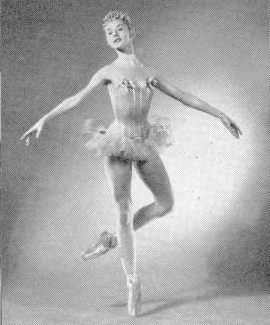
New York City Ballet (NYCB) is a ballet company founded in 1948 by choreographer George Balanchine and Lincoln Kirstein. Balanchine and Jerome Robbins are considered the founding choreographers of the company. Léon Barzin was the company's first music director. City Ballet grew out of earlier troupes: the Producing Company of the School of American Ballet, 1934; the American Ballet, 1935, and Ballet Caravan, 1936, which merged into American Ballet Caravan, 1941; and directly from the Ballet Society, 1946.

Jacques d'Amboise was an American ballet dancer, choreographer, and educator. He joined the New York City Ballet in 1949 and was named principal dancer in 1953, and throughout his time with the company he danced 24 roles for George Balanchine. He also made film appearances, including Seven Brides for Seven Brothers and Carousel. He choreographed 17 ballets for the New York City Ballet and retired from performing in 1984.
Linda Ann Crist was a noted labanotation expert, documenting, writing, and teaching labanotation. Labanotation is a type of notation that captures dance movements on paper, similar to how musical notation captures musical performances. It allows for accurate reproduction of specific choreography by other dancers or dance troops at a later time.

Tanaquil Le Clercq was an American ballet dancer, born in Paris, France, who became a principal dancer with the New York City Ballet at the age of nineteen. Her dancing career ended abruptly when she was stricken with polio in Copenhagen during the company's European tour in 1956. Eventually regaining most of the use of her arms and torso, she remained paralyzed from the waist down for the rest of her life.
Pas de deux is a ballet duet in which steps are performed together.

Stars and Stripes is a neoclassical ballet choreographed by George Balanchine to music by John Philip Sousa, orchestrated by Hershy Kay. The ballet was made as a tribute to the United States, Balanchine's adopted country. It premiered on January 17, 1958, at the City Center of Music and Drama, danced by the New York City Ballet. It is dedicated to Fiorello La Guardia, former mayor of New York City. The ballet had been revived by multiple ballet companies, and at different special occasions.

Tchaikovsky Pas de Deux is a ballet choreographed by George Balanchine to a composition by Pyotr Ilyich Tchaikovsky originally intended for act 3 of Swan Lake. With costumes by Barbara Karinska and lighting by Jack Owen Brown, it was first presented by New York City Ballet at the City Center of Music and Drama, New York, on 29 March 1960. Robert Irving conducted the New York City Ballet Orchestra. The dancers were Violette Verdy and Conrad Ludlow.
A danseur noble traditionally was a male ballet dancer who projected great nobility of character. Over the last century, the term has been used to define a male principal dancer who performs at the highest theatrical level combining grace with ability. Some use danseur noble as the masculine equivalent to a Prima Ballerina, or to refer to the male partner of a ballerina during a pas de deux.

Episodes is a ballet choreographed by Martha Graham and George Balanchine, to compositions by Anton Webern. The ballet was a co-production between the Martha Graham Dance Company and Balanchine's New York City Ballet (NYCB). Though it was conceived to be a collaboration between Graham and Balanchine, leading choreographers in modern dance and neoclassical ballet respectively, they ultimately worked separately on the ballet's two halves. Episodes I was choreographed by Graham, for dancers from her company and four NYCB members, and depicts Mary, Queen of Scots remembering the events in her life before her execution. Episodes II, by Balanchine, is completely plotless, and made for members of the NYCB and Graham dancer Paul Taylor, who originated a solo. The ballet uses all seven orchestral compositions by Webern.
Andantino, originally titled Pas de Deux, is a ballet choreographed by Jerome Robbins to the second movement of Tchaikovsky's Piano Concerto No. 1. The ballet was made for the New York City Ballet's Tchaikovsky Festival, and premiered on June 4, 1981, at the New York State Theater, originated by Darci Kistler and Ib Andersen.
In G Major is a ballet choreographed by Jerome Robbins to Maurice Ravel's Piano Concerto in G Major. Performed by a cast of fourteen, the ballet featured Broadway-inspired choreography. The ballet was created for the New York City Ballet's Ravel Festival, which celebrated the centenary of Ravel, and premiered on May 15, 1975, at the New York State Theater, with Suzanne Farrell and Peter Martins originating the two lead roles.
Union Jack is a ballet made by New York City Ballet co-founder and founding choreographer George Balanchine to traditional British tunes, hornpipe melodies and music-hall songs, ca. 1890–1914, adapted by Hershy Kay. The premiere took place on 13 May 1976, at the New York State Theater, Lincoln Center, to honor British heritage in the United States its bicentennial with costumes by Rouben Ter-Arutunian, original lighting by Ronald Bates and current lighting by Mark Stanley. At the finale the ensemble spells out "God Save the Queen" in semaphore code and the Union Jack unfurls. Principal dancer Jock Soto included an excerpt from Union Jack in his farewell performance in June 2005.
Mozartiana is a ballet choreographed by George Balanchine to Tchaikovsky's Orchestral Suite No. 4, Mozartiana. The current version of the ballet was made for New York City Ballet's Tchaikovsky Festival, and premiered on June 4, 1981, at the New York State Theater. It is considered Balanchine's last major work.
Raymonda Variations, formerly titled Valses et Variations, is a ballet choreographed by George Balanchine to excepts from Alexander Glazunov's score for the 1898 ballet Raymonda. Instead of following the plot of the 1898 ballet, the Balanchine ballet is plotless. It premiered on December 7, 1961, at the City Center of Music and Drama. Raymonda Variations was made for the New York City Ballet, with the two lead roles originated by Patricia Wilde and Jacques d'Amboise.

William Dollar was an American dancer, ballet master, choreographer, and teacher. As one of the first American danseurs nobles, he performed with numerous companies, including the Philadelphia Opera Ballet, the American Ballet, Ballet Caravan, Ballet Society, Ballet Theatre, and New York City Ballet.

Who Cares? is a ballet choreographed by George Balanchine to songs by George Gershwin that were orchestrated by Hershy Kay. The ballet is split in two parts, the first danced by an ensemble, and the second focuses on four principal dancers. Who Cares? premiered on February 5, 1970, at the New York State Theater, danced by the New York City Ballet.

Diana Adams was a principal dancer for the New York City Ballet from 1950 to 1963 and favorite of George Balanchine, later becoming a teacher at — and dean of — the School of American Ballet.

André Prokovsky was a Franco-Russian ballet dancer, choreographer, and company director. Admired as a bravura performer and an innovative choreographer, he had a varied career that was broadly international in scope.
After the Rain is a ballet choreographed by Christopher Wheeldon on New York City Ballet to music of Arvo Pärt, including Tabula Rasa and Spiegel im Spiegel. The ballet premiered on January 22, 2005, at the New York State Theater, Lincoln Center. The final pas de deux is commonly performed separately from the remainder of the ballet.
Movements for Piano and Orchestra is a neoclassical ballet choreographed by George Balanchine to Stravinsky's score of the same name. The ballet premiered on April 9, 1963, at City Center of Music and Drama, performed by the New York City Ballet. Though the two lead roles were created for Diana Adams and Jacques d'Amboise, seventeen-year-old Suzanne Farrell danced the female lead at the premiere due to Adams' pregnancy. Starting in 1966, Movements and Monumentum pro Gesualdo (1960) are performed together.









